 |
| |
| A key challenge for the SSW Programme is how to help property managers and residents identify space for collecting separated waste. Many housing estates cannot accommodate waste separation bins on each building floor; additionally, there are concerns that fire escape routes could be blocked by placing waste separation bins on staircase landings or other common areas on each floor. Some estates also worry that the costs of setting up waste separation facilities will be too high. |
|
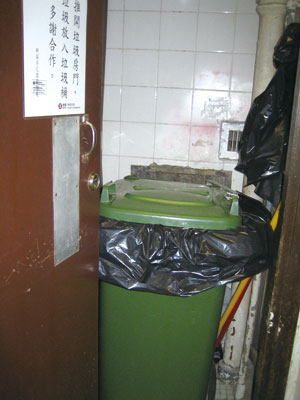 |
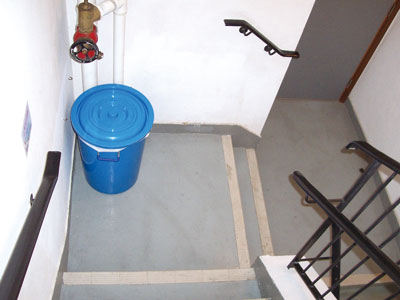
Floor-based refuse rooms and staircase landings generally have limited space for accommodating waste separation facilities. |
|
The Government has been addressing all of these concerns through a series of measures to support the Programme. In 2008 we made regulatory changes to building codes to require new buildings to include storage areas for recovered waste. The amendment to the Building (Refuse Storage and Material Recovery Chambers and Refuse Chutes) Regulations under the Buildings Ordinance states that all new domestic buildings and the domestic part of new composite buildings must provide a refuse storage and material recovery room at least 1.5 metre x 1.5 metre in size on every floor to facilitate residents’ participation in waste recovery. The amendment came into effect 1 December 2008. |
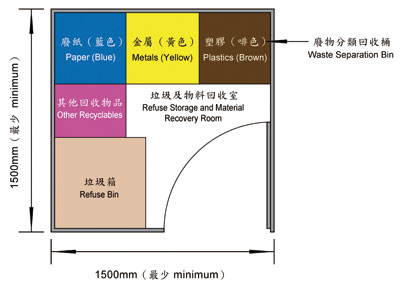
|
Refuse storage and material recovery rooms should be at least 1.5 metres x 1.5 metres to provide sufficient space for waste recovery. |
 |
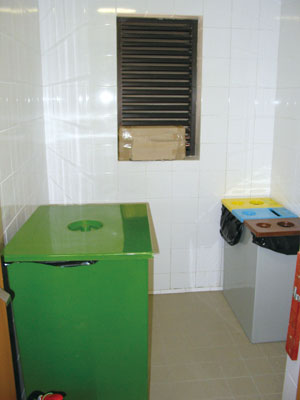 |
Refuse storage and material recovery rooms facilitate waste separation and recovery in the new buildings. |
We also have several on-going initiatives to support domestic source separation of waste:
- A “Guidebook on Source Separation of Waste in Residential Buildings” has been published which provides advice on how to practise source separation of waste on each floor of residential buildings. It also explains the building and fire safety regulations related to the Programme.
|
|
|
The “Guidebook on Source Separation of Waste in Residential Buildings” provides advice on how to practice source separation of waste on each floor of residential buildings. |
|
- Government officers regularly visit housing estates and buildings and attend residents’ meetings to answer questions and provide advice on matters such as where to purchase bins, where to locate the bins and where to send recovered recyclables. By the end of 2008 we had visited more than 1,800 estates, many of which have either joined the Programme or are making arrangements to do so.
|
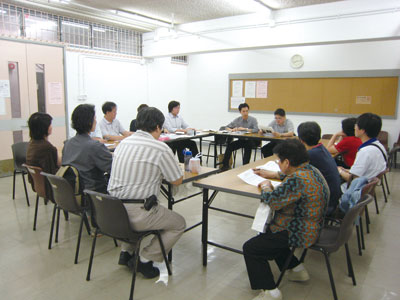 |
|
- EPD staff attend a meeting of residents’ organizations to provide advice and answer questions on implementing source separation of waste.
|
|
- The Environment and Conservation Fund provides partial funding support to private housing estates that join the Programme. Successful applicants can receive a subsidy of 50% of the total set-up cost for installing waste separation facilities on each building floor, up to a maximum of $800 per building floor. By the end of 2008, 130 applications had been received and 100 applications had been awarded grants worth a total of $4.2 million.
|
|
| Members of the Environment and Conservation Fund (ECF) Waste Recovery Projects Sub-Committee visit a housing estate with waste separation facilities funded by the ECF. |
|
|
- To support the promotion of waste separation at source, the Environmental Campaign Committee (ECC) has produced newly designed waste separation bins which are made of materials that can be recycled and have larger openings to facilitate the public to put in recyclables of larger sizes. Free waste separation bins are distributed to housing estates and buildings by ECC, with one set of bins earmarked for each building.
|
 |
These 200-litre plastic waste separation bins are suitable for outdoor use.
|
|
| This metal composite waste separation bin is suitable for indoor use. It has three 50-litre compartments for collecting paper, plastics and metals. |
|
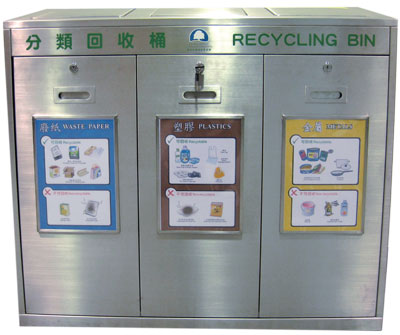 |
|
|
|